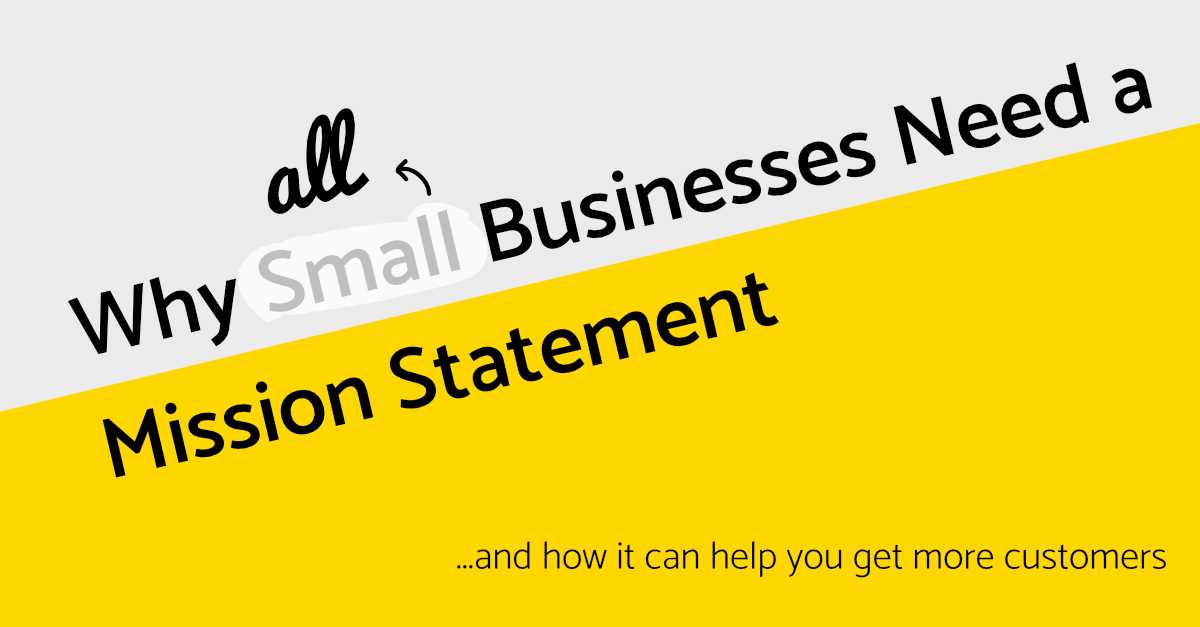Wouldn't it be great it there was a little paragraph you could direct people towards when they asked what your company does?
Wouldn't it be even better if that paragraph not only helped customers or investors learn what you do, but also why you do it?
So wouldn't it be a much greater tool if that paragraph also helped you make sales, with no additional sales effort?
- Welcome, to the Mission Statement
- Value
- Personas, Pains and Gains
- You, the Problem Solver
- The Power of a Mission Statement
Welcome, to the Mission Statement
The definition, according to our friend Google, of a Mission Statement is:
a formal summary of the aims and values of a company, organization, or individual
Simple, hey?
So a Mission Statement is just you explaining what your businesses goals are and why you do what you do, right? Easy, so here we go:
Our mission is to sell more product each month than the previous one, in order to make more money so that we can go to the Caribbean every year on holiday. We commit to up-selling every customer who walks through the doors and encourage them to buy products we make the largest profit on. We only value our customers who spend the most money with us, which helps us meet our profit goals and allows us to repeat book a 5 Star Spa Hotel in Antigua.
Feel free to copy and paste that onto your Facebook Business page or your website, free Mission Statement, win!
It clearly describes what the aims of the business are, and how the business plans to achieve those goals along with the values of the business, right there in black and white. What's really nice is that it also evokes a strong feeling in your stomach of what it would be like to walk through the doors of this business. Great, yeah?
Please, please don't use that.. we all know it's a bad idea, and even if you've never written one or heard of one before, we all know that it's an absolutely terrible Mission Statement. I can't be held responsible for the damage that would do to your business!
Let's get in to how you should really write a great Mission Statement..
Value
The key thing you need to consider when writing a Mission Statement is the value that your business provides it's customers. Value is one of the biggest factors in running a successful business as it determines just how much customers are willing to spend on your product or service, I'll cover more of this in another article.
Value as we're using it should not be confused or associated with the connotations around a 'value product range' in a supermarket. The value we're referring to is the true meaning of the word, regarding importance, worth, and usefulness.
To get a real grasp on your mission statement, you need to understand the value that you are offering your customers. For example, personally I cannot bake cupcakes, but I also really like cupcakes - especially ones with sprinkles. Therefore I would find a shop that sells sprinkle topped cupcakes valuable, and I would be happy to pay for these cupcakes as I can't make them myself. If they were local, or offered delivery, they would become even more valuable because it requires me to make less effort.
Equally, I'm not a qualified or even unqualified plumber. Therefore when the pipes under my kitchen sink start leaking and flooding my kitchen, I put high value onto a plumber who can turn up at 11pm to save my kitchen from becoming a swimming pool.
Value is not related to money in these examples, value in this sense is a combination of requirement or desire and personal ability. If I hated cupcakes, I wouldn't value a local cupcake delivery service. Just as if my sink wasn't leaking I wouldn't value a late night plumber.
Those 2 examples were flipping the requirement or desire principle, but also if I was a fantastic cupcake maker I wouldn't value the cupcake company nearly as highly, just as if I were a plumber I wouldn't value a late night plumber.
Personas, Pains and Gains
In order to write a Mission Statement that both perfectly describes your business and connects with customers, you need to profile your customers or your potential customers.
Profiling is something you would have done when you started your business - even if you didn't realise you were doing it.
You can either use your imagination and experience to create customer profiles, or if you've been up and running for a while you can use your experience with real customers and generalise a little bit.
I'll go over Customer Personas or Profiling and how they can help your business in more depth in another article, but generally what you need to do is think about your ideal customer, even if that isn't the type of customer you are currently getting, and put yourself in their shoes.
Once you've done the laces up, you need to attempt to empathise with their complete lifestyle. Are they male or female, what type of job do they do, what are their hobbies, where do they hang out, are they extroverted or introverted, are they well off or live more modestly, what car do they drive?
The more of a clear picture you can get of your ideal customer the better.
Once you've done this, and take your time doing it, it shouldn't be too much more of a mental stretch to imagine what their pains and gains are in life. Pains, challenges or problems being what do they struggle with, what things do they aspire towards or wish to achieve? Also the counter of that, what are their Gains in life, what's going really well for them, what do they do that they love, what makes them the happiest, what are they the most proud of?
You, the Problem Solver
At this point you've got a pretty clear picture of your ideal customer, now you need to put your business into the picture.
Focus on the pain points and challenges that your customers have and how you as a business can help solve these problems for them.
Immediately after doing this, we've found that we can be valuable to our customers. We know that they have problems, and we know that we have the ability to solve these problems for them through our business either selling products or services.
Let's imagine we own a bakery called The Cupcake Bakery (creative, right?) and we have created a persona for the type of customer we'd like to have:
- Name: Elizabeth Green
- Age: 36
- Works full time
- Doesn't have the time to bake regularly
- Capable of baking basic items
- Has a family of 4 with 2 young children
- Occasionally visits the local high street
- Feels pride in buying from independent shops and helping the community
- Impulse buyer
- Favours ease of purchase over cost
- Prefers to buy things from a reputable looking company rather than 'pop up shops'
The Power of a Mission Statement
So now with our customer persona created we could write something like this:
At The Cupcake Bakery, not only do we create a large range confectionary of the highest quality using local produce, but we also provide tailored and customised bakes for events. We understand the intricacies of baking all types of goods, and believe that nobody should miss out on the best local products. Therefore we are committed to doing everything we can do bring our products to the high street and also straight to our loyal customers' doorsteps.
Now our Mission Statement matches the type of customer we want to have walking through our door or ordering from our website or Facebook business page.
We can use this Mission Statement on our website, or anywhere else for that matter, so that potential customers can get an immediate feel for the type of business, it's beliefs, values, aims and goals.
Our original Mission Statement just went on about making money - which is honestly the goal for any business including charities, however our new Mission Statement doesn't mention money or holidaying in the Caribbean anywhere... must be a mistake, a typo?
But here's the thing, with a Mission Statement that talks directly to your customers wishes and needs, you will continue to get more of the exact type of customers you want, your existing customers will be reminded why they came to you in the first place and therefore you will make more money and grow your business.
Enjoyed this article or found it useful? Please post a comment back where you found this article, and also click here to read more blog posts and articles

